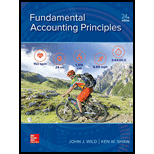
Concept explainers
Concept Introduction:
Journals:
Journals are prepared to record business transactions. There are two types of journals:
- Special Journals:
Special journals record the recurring business tractions like sales, purchase, cash receipts and payments. Some special journals are as follows:
- Sales journal
- Sales Return Journal
- Purchase journal
- Purchase return journal
- Cash receipts journal
- Cash payment journal
- General Journal:
All the business transactions which do not belong to special journals, are recorded using General journal.
General ledger:
A general ledger contains the summarized information taken from its subsidiary ledgers.
Subsidiary Ledger:
A Subsidiary Ledger is prepared for the one account of the general ledger. There may be several subsidiary ledgers of one general ledger.
Requirement-1:
To identify:
The balances listed in the
Concept Introduction:
Journals:
Journals are prepared to record business transactions. There are two types of journals:
- Special Journals:
Special journals record the recurring business tractions like sales, purchase, cash receipts and payments. Some special journals are as follows:
- Sales journal
- Sales Return Journal
- Purchase journal
- Purchase return journal
- Cash receipts journal
- Cash payment journal
- General Journal:
All the business transactions which do not belong to special journals, are recorded using General journal.
General ledger:
A general ledger contains the summarized information taken from its subsidiary ledgers.
Subsidiary Ledger:
A Subsidiary Ledger is prepared for the one account of the general ledger. There may be several subsidiary ledgers of one general ledger.
Requirement-2:
To identify:
The Accounts receivable general ledger balance at the end of the month
Want to see the full answer?
Check out a sample textbook solution
Chapter 7 Solutions
Fundamental Accounting Principles
- I am searching for the correct answer to this general accounting problem with proper accounting rules.arrow_forwardI need the correct answer to this general accounting problem using the standard accounting approach.arrow_forwardCan you help me solve this general accounting question using valid accounting techniques?arrow_forward
- I need guidance with this general accounting problem using the right accounting principles.arrow_forwardCan you solve this general accounting question with the appropriate accounting analysis techniques?arrow_forwardCan you explain the correct approach to solve this general accounting question?arrow_forward
- Joe and Ethan each own 50% of JH Corporation, a calendar year taxpayer. Distributions from JH are: $750,000 to Joe on April 1 and $250,000 to Ethan on May 1. JH’s current E & P is $300,000 and its accumulated E & P is $600,000. How much of the accumulated E & P is allocated to Ethan’s distribution? a. $0b. $75,000c. $150,000d. $300,000e. None of the above b or c?arrow_forwardPlease provide the accurate answer to this general accounting problem using appropriate methods.arrow_forwardI need guidance with this general accounting problem using the right accounting principles.arrow_forward

 AccountingAccountingISBN:9781337272094Author:WARREN, Carl S., Reeve, James M., Duchac, Jonathan E.Publisher:Cengage Learning,
AccountingAccountingISBN:9781337272094Author:WARREN, Carl S., Reeve, James M., Duchac, Jonathan E.Publisher:Cengage Learning, Accounting Information SystemsAccountingISBN:9781337619202Author:Hall, James A.Publisher:Cengage Learning,
Accounting Information SystemsAccountingISBN:9781337619202Author:Hall, James A.Publisher:Cengage Learning, Horngren's Cost Accounting: A Managerial Emphasis...AccountingISBN:9780134475585Author:Srikant M. Datar, Madhav V. RajanPublisher:PEARSON
Horngren's Cost Accounting: A Managerial Emphasis...AccountingISBN:9780134475585Author:Srikant M. Datar, Madhav V. RajanPublisher:PEARSON Intermediate AccountingAccountingISBN:9781259722660Author:J. David Spiceland, Mark W. Nelson, Wayne M ThomasPublisher:McGraw-Hill Education
Intermediate AccountingAccountingISBN:9781259722660Author:J. David Spiceland, Mark W. Nelson, Wayne M ThomasPublisher:McGraw-Hill Education Financial and Managerial AccountingAccountingISBN:9781259726705Author:John J Wild, Ken W. Shaw, Barbara Chiappetta Fundamental Accounting PrinciplesPublisher:McGraw-Hill Education
Financial and Managerial AccountingAccountingISBN:9781259726705Author:John J Wild, Ken W. Shaw, Barbara Chiappetta Fundamental Accounting PrinciplesPublisher:McGraw-Hill Education





